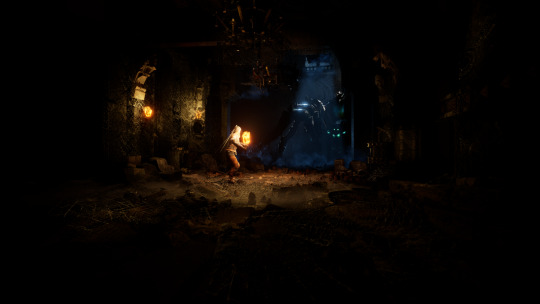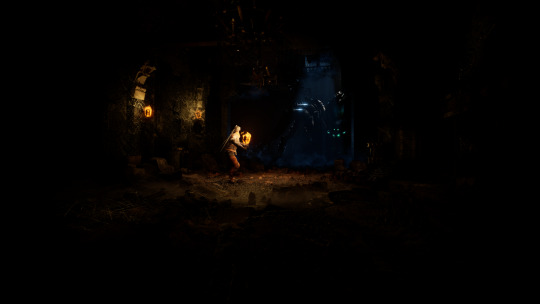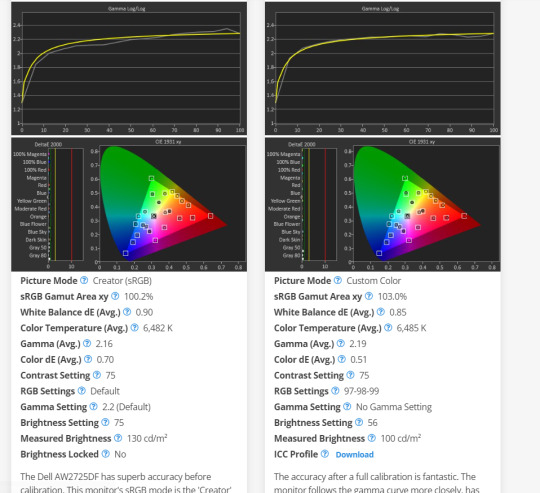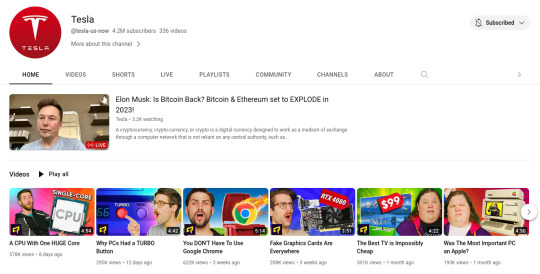#Techquickie
Explore tagged Tumblr posts
Text
Blog Post 34: Final Project 1: Week 6 Final Edits
In this blog we will discuss the finalization of project 1 “Castle of Webs”. In this blog I will discuss the issues in terms of lighting that were experienced, and how these issues were resolved, to make the final edits to the project.

With the final adjustments to both the lighting as well as the slight tweaks to the post processing, “Castle of Webs” has finally reached its completion. It has been a tough road but the process of adapting and changing the lighting to best suit the contrast of different monitors required research and updates to achieve the right blance of contrast, across multiple monitors.
Progression:
The first time I realized that my scene was dark, was when I tried to open the rendered scene on my mobile phone. Not only was the image extremely dark, but the flames and lighting from the torches and global illumination appeared to be low in contrast level as well.

But when I tried to recheck the render on my OLED monitor, I found the image to be exactly how I envisioned it to be and thought that it might be the fault of a low-quality render instead of lighting itself. I tried to re-render the scene, but found the same problem being persistent whenever I tried to view the scene on any other device other than my OLED monitor. I then tried to re-export the image in a png file format, thinking the lossless format of the png might allow the scene to be rendered a bit better, but the results were the same.
youtube

At this point, I tried researching the color accuracy and contrast ratio of my OLED monitor as well as that of my secondary display and there I discovered the primary culprit. With a greater peak brightness as well as substantially higher contrast ration, the OLED monitor was simply capable of displaying a far higher and brighter image than its counterparts.
youtube
youtube
To solve this problem, apart from adding several diffused light sources, I also increased the contrast ratio of the entire scene, which made the scene appear much better/ brighter on other monitors. I also decreased the bloom and changed the volumetric fog settings to make sure that the scene did not appear too bright as well. Finally, with all the settings dialed in, I completed the final renders of my scene and completed the project.

Final thoughts:
At the end of the development process, I personally feel extremely fortunate to have learnt so much on a relatively limited project. From developing assets to attain certain mood and atmosphere, to designing levels while keeping peripheral limitations in mind. Each of these hurdles allowed me to learn new and essential skills that will undoubtedly be useful in the future. While I could not achieve my initial goal of creating 3 unique levels, I am still extremely happy to have managed to achieve my set goal in the given time period.
RESOURCES USED:
optimum (2023). OLED vs IPS – 3 Months Later. [online] YouTube. Available at: https://www.youtube.com/watch?v=_jGtEqkenBg [Accessed 7 Dec. 2024].
Techquickie (2017). What is Contrast Ratio? [online] YouTube. Available at: https://www.youtube.com/watch?v=huWbl-vIogc [Accessed 7 Dec. 2024].
Royal Skies (2024). Unreal 5 - Post Process VOLUME (3 MINUTES!!). [online] Available at: https://www.youtube.com/watch?v=InSXTn3QVr4. [Accessed 9 Dec. 2024].
RTINGS.com. (2024). RTINGS.com. [online] Available at: https://www.rtings.com/monitor/reviews/dell/alienware-aw2725df.
SKILLS I LEARNED
Working with different peripherals
Contrast Ratios
Post Process Volume
0 notes
Video
youtube
What is Anti Aliasing (AA) as Fast as Possible
5 notes
·
View notes
Photo

LinusTechTips and TechQuickie YouTube channels got hacked today. YouTube then terminated those channels. The screenshot is of the page right before the channel getting terminated.
0 notes
Text
riley murdock my beloved
#sometimes I watch a techquicky video from riley before bed just so I'll hear his narrator ass voice#so soothing ugh#no wonder he's a voice actor as well#rambles*
1 note
·
View note
Text
me last week: i dont get people who watch youtube videos sped up to like 1.5x the speed!!! how do you understand everything??? why cant you watch it at the normal speed???
me now, speaking as if i just chugged 2 gallons of coffee: id rather die than watch a youtube video at anything other than 2x speed
#mine#me watching techquickie at 2x speed: I Am Truly As Fast As Possible#also if what ur watching is like. teaching you abt a concept or has facts#you leave the physical plane as the knowledge rushes into your brain
6 notes
·
View notes
Photo

New Post has been published on https://toldnews.com/technology/magic-leap-raises-280-million-from-ntt-docomo/
Magic Leap Raises $280 Million From NTT DoCoMo

Magic Leap, the maker of augmented-reality goggles, has already raised $2.3 billion, an extraordinary amount for a start-up. Now it has secured yet another investment — and could raise still more cash.
The company said Friday that it had garnered $280 million from NTT DoCoMo, Japan’s biggest cellphone service provider, as part of a new partnership between them. It will also reopen its most recent fund-raising round to potentially accept even more cash from new and existing investors.
It is the latest move by Magic Leap to build its vision of making its flavor of augmented reality — where people see computer-generated images in the real world, thanks to a special headset — ubiquitous.
That pitch has enabled the company to become one of the best-funded start-ups around. But it also raises questions about whether Magic Leap, which began shipping its headset last year for $2,300, can make good on its promise, especially as it faces competition from technology giants like Microsoft.
Magic Leap has responded partly by forming strategic and financial bonds with big telecom partners that could introduce its technology to consumers and business customers. Last year, the company struck a partnership with AT&T, which now sells the Magic Leap One in a handful of cities in the United States.
By teaming up with DoCoMo, Magic Leap hopes to serve a similar role for another major market. Beyond the ability to expose more potential customers to the Magic Leap One, a forthcoming gigabit high-speed internet service from DoCoMo could help advance augmented reality applications.
“They’re a forward-looking company,” Rony Abovitz, Magic Leap’s founder and chief executive, said of DoCoMo in an interview. “I think this is quite transformational for us and for the country.”
DoCoMo’s funding is also important for Magic Leap as it competes against deeper-pocketed rivals. Microsoft rolled out the second version of its competing HoloLens this year, with an eye on capturing the potentially lucrative market for business users, like factory workers.
Mr. Abovitz said any progress would continue to be expensive. “The R&D investments are substantial, but so is the upside,” he said.
He said the company had previously let expectations for its product run wild. “I think our job is to continue to manage expectations,” Mr. Abovitz said. He added that he believed augmented reality could help lay the road for the next generation of the internet.
In a tacit acknowledgment of the costs of its business, Magic Leap will reopen its Series D fund-raising round. Mr. Abovitz said the company was in talks with more potential investors.
One of its current backers is the sovereign wealth fund of Saudi Arabia, whose government has drawn criticism for its role in the killing of the journalist Jamal Khashoggi. Mr. Abovitz declined to comment on the Saudi sovereign wealth fund.
#evolution of technology news#news techquickie#technology news 1985#technology news forbes#technology news hindu#technology news vietnam
0 notes
Text
Why web browsers are free
youtube
Status Post #8995: I believe that it's among the most used apps in either your PC or mobile device.
0 notes
Text
5 Channels I am Subscribed (#19)
5 Channels I am Subscribed (#19)
Today’s next 5 YouTube channels are:
TechLead
TechLinked
Techlore
Techquickie
Tested
There are a lot of “Tech” somethings this time around. Let’s get started…
TechLead. A man with a unique sense of humor. A man, who is theTechLead. Joking aside, what we have here is a man who has strong experience in the programming world include time spent working for Google. Videos go over tech and related…
View On WordPress
0 notes
Text
Some info for starters
Good morning my future readers! (at least it’s morning where I am)
I thought I’d add another post where I’d share with you where I find and follow news from tech industry.
Let me start by mentioning my favorite tech portal:
https://www.bug.hr/
This is a fully Croatian news portal where one can follow all kinds of different tech news, from new Apple gadgets to gaming tournament results all the way to audio equipment reviews and what not.
It does have a certain delay because they take the news from other much more popular foreign sites, but is very nicely decorated and there is a forum with a lot of helpful people!
Of course, you might not find it as interesting since it does not offer an English version :// But fear not! If you right-click and translate the site to English you will get a near perfect translation and will be able to understand everything written there, I tried it myself. :)
Next is my favorite tech Youtube channel:
Linus Tech Tips
and their “side” channel called:
Techquickie
You should definitely check them out if you didn’t already for amazing product reviews, myth busting, product analysis, news talk shows and educational tech videos.
Those are my main news sources. Apart from them, I often use Twitter where I follow different tech companies’ profiles and they post their product news or giveaways and other fun stuff!
I often visit companies’ local sites themselves, like Apple or Spotify Newsroom websites to find official news that particularly interest me.
More about Spotify in another post, there are some things I would like to share with you about the platform. :)
So that’s that for now! Thank you for reading this I hope I made it at least mildly interesting. :D
I’ll definitely post more in the coming days and maybe give more info about myself. Since this is supposed to be a tech and also controversy blog, I thought I’d start with a post like this.
See you later!
- Frle
#tech#technology#tech news#news#news portal#youtube#bug online#croatia#spotify#product#forum#linus tech tips#techquickie
0 notes
Text
How Does Your Web Browser Know Your Location?
Technology: How Does Your Web Browser Know Your Location? — Techquickie, Technology, Bulletin, nybulletins — Shared by: Techquickie (on Youtube). EST: December 22, 2017 at 01:59PM You may also like: More from this site: How Does Your Web Browser Know Your Location?How…
View On WordPress
0 notes
Photo


1 note
·
View note
Photo

#iPhone8 will have only 2 model not 3 http://ift.tt/2oAYoSz
0 notes
Text
Techquickie: The COOLEST Features in iOS 13
Techquickie: The COOLEST Features in iOS 13
Check out this new Techquickie video! Link: https://youtu.be/CPV0tYV5I8I
The first 200 people who head to https://ift.tt/2AAiW1L will get 20% off their annual premium subscription of Brilliant.
What should we expect from the latest version of iOS?
Linus Tech Tips Merch Store: https://ift.tt/2zNfiRu
Follow: http://twitter.com/linustech
Leave a reply with your requests for future episodes, or tweet…
View On WordPress
5 notes
·
View notes
Text
Linus Media Group Hack



'My channel was deleted last night' | 'We Got Hacked'
Yesterday was quite a surprise as the biggest tech Youtuber on the platform, Linus Tech Tips along with side channels Techlinked and Techquickie were hijacked to advertise a devious Crypto scam livestream (which is actually pre-recorded) on an early Canadian morning. Everything about the profiles were changed to Tesla with thousands of videos either deleted or privated. This is far from the first occurrence, being well known between Youtubers and it's community for months now, yet Google/Youtube have not addressed anything.
What made things worse however is that in a recovering process, loads of personal + test videos were made public for a short duration (also out of respect, I cannot link reuploads/backups)! But luckily now everything has been reversed. With the situation now behind us, all we can do is hope Youtube finally does something to minimise situations like this in future. The moral? Always take security seriously! Different passwords on everything (upside down letters, symbols, numbers, even a random underscore sometimes), seperate personal email addresses from business ones, never share any tokens or cookies to anybody, etc). With that said, thank you so much for reading! Have a wonderful day.
🎴My Carrd | 💰Tip my Ko-fi (helps a ton) | ✍️Written by @frozaru
0 notes
Photo

New Post has been published on https://toldnews.com/technology/after-the-bust-are-bitcoins-more-like-tulip-mania-or-the-internet/
After the Bust, Are Bitcoins More Like Tulip Mania or the Internet?

SAN FRANCISCO — When you talk to tech industry insiders about where Bitcoin is heading, two vastly different comparisons are inevitable: the tulip bulb and the internet.
Bitcoin’s critics say the digital tokens are like the tulip bulbs of 17th-century Holland. They generated a wild, speculative rush that quickly disappeared, leaving behind nothing but pretty flowers and wrecked bank accounts.
Bitcoin believers, on the other hand, want us to think about cryptocurrencies as if they were the internet: a broad technology category that took some time to reach its potential, even though expectations got ahead of reality in the early years. If that’s true, last year’s crash in Bitcoin prices was like the dot-com bust; a temporary setback before the big ideas come to fruition.
After following Bitcoin for several years, I think neither of these comparisons quite works. Bitcoin is neither an irredeemable flop nor an economic miracle.
So what is it? We are still a few years from any sort of clarity about where this technology will fit in the world. If we want to imagine where it might be going, we need to look beneath the gyrating price to understand how it is being used today and who is using it.
Speculators, drug dealers and the oppressed: How cryptocurrencies are used right now
At the most basic level, Bitcoin has introduced a new way to hold and send around value online. Anyone can open a Bitcoin wallet and receive money from a friend or a stranger. The system works without any central authority, thanks to a network of computers that is not unlike the network of computers supporting the internet.
Even after last year’s bust, Bitcoin users are generally sending somewhere between $400 million and $800 million worth of Bitcoin across the network every day, according to data from the blockchain, the public ledger on which all Bitcoin transactions are recorded.
That daily volume is less than half the daily average of the payment service PayPal. But it is much more activity than the network handled before the price spiked in 2017.
As the proponents of the tulip bulb version of Bitcoin will tell you, most of the transactions today are speculative: people buying and selling Bitcoin in the hope that it will be worth more in the future. A more generous viewpoint would compare Bitcoin to gold, a scarce commodity that goes up and down in value and provides an alternative to national currencies.
Speculative transactions accounted for roughly 60 to 80 percent of all transactions on the blockchain, according to Chainalysis, a start-up that does analysis of the blockchain for big companies and governments. Most of those transactions are Bitcoins moving between cryptocurrency exchanges around the world.
There is still quite a bit of mystery about what accounts for the other 20 to 40 percent of the transactions. No one can force Bitcoin users to register their identity, so Chainalysis and other firms are in the dark about many transactions. But they have identified some useful chunks.
When Bitcoin was introduced in 2009, it was described as a new way to make payments online, without the fees that credit card companies charge. Chainalysis estimates that last year, companies handling Bitcoin payments accounted for 0.3 percent of all Bitcoin transactions, or $2.4 billion.
This is a healthy dose of apparently legal commerce, but it was not a good sign for Bitcoin that it was shrinking for most of last year when the price of Bitcoin was going down, according to Chainalysis data.
Many if not most Bitcoin advocates I’ve encountered will admit it doesn’t offer much of an improvement over traditional electronic methods of payment. In several ways, it’s worse. Paying with Bitcoin requires you to become a speculator on its volatile price for the time you are holding on to tokens and waiting to pay.
The payment data leads to the question of where this technology might gain momentum, beyond speculation. The most compelling use that Bitcoin fanatics talk about is its value to people in repressive countries that have currencies that are even more volatile than Bitcoin.
In Venezuela, for example, Bitcoin can offer a way to move savings out of the inflating bolívar. Because of the open nature of Bitcoin, Venezuelans can buy it without the government stopping them.
There are stories of Venezuelans using Bitcoin to rescue their savings. Venezuelans bought over $230 million in Bitcoin last year on the most popular platform for sales, LocalBitcoins, according to the data analyst Matt Ahlborg. Those purchases were growing even as the price of Bitcoin was falling.
But it caught on with only a tiny sliver of Venezuelans. And there are reasons to wonder how many of these transactions were really just corrupt government officials or wealthy Venezuelans who had other means of getting their money out of the country.
People who have traveled to Venezuela have told me that most ordinary people they spoke to would prefer to have their money in dollars instead of Bitcoin.
The bigger problem facing Bitcoin is that the practical and legal uses have struggled to outpace illegal or clearly unethical activity.
The list of ways that Bitcoin has proved useful to criminals keeps growing, from the ransom payments on locked-up computer files — or even hostages — to illegal drug sales.
Many of these misdeeds are hard to quantify, but Chainalysis has managed to put numbers on Bitcoins used to buy drugs on the so-called dark net. Chainalysis numbers show that drug purchases rose last year, even when the price of Bitcoin was falling.
The total dark net transactions in 2018, around $620 million, were more than twice the amount that Venezuelans bought on LocalBitcoins.
Bitcoin fans will tell you that this is a drop in the bucket compared with how much the dollar is used to buy drugs. But all the data I’ve seen suggests that drug purchases account for a much larger proportion of the Bitcoin economy than their proportion of the dollar economy. And Bitcoin has enabled new kinds of deadly drug traffic, like the synthetic opioids that have flowed from China to small towns in the United States.
Illegal activity, and especially pornography, played an important role in the early internet, but nothing like what we’ve seen from Bitcoin in its early days.
Bitcoin is accessible to anyone — not so different from the internet. The problem is that, other than speculation, none of its legitimate uses have taken hold at anything like the pace of the illegal activity.
Ethereum, Dapps and Facebook: Looking to the future
That the technology hasn’t gained traction with ordinary people does not mean it won’t someday. There are still plenty of areas where, smart entrepreneurs think, the open nature of cryptocurrencies could be useful.
Many venture capitalists have made bets on Ethereum and EOS, alternative cryptocurrency networks that can be programmed for more sophisticated applications, like financial contracts, than Bitcoin’s software allows.
Programmers have already built thousands of so-called decentralized applications, or Dapps, that use the EOS and Ethereum tokens. Many of them can be used today. These Dapps can move money around and record ownership of digital goods, like items in video games, without a central company keeping the records.
But a majority of these Dapps still focus on legal gray zones, like gambling. The most prominent use of Ethereum so far has been by companies, many of them scams and frauds, that wanted to raise money without complying with securities regulations, through so-called initial coin offerings.
I have seen little indication that any of the more legitimate uses have worked easily enough to have any appeal beyond cryptocurrency fanatics.
Perhaps the biggest thing that cryptocurrencies have going for them is that serious people still want to fix the flaws. The value of digital tokens — however volatile they may be — has created incentives for people to work on them.
The latest big cryptocurrency player is Facebook, which is said to be working on its own digital tokens. So are several other big messaging companies.
I can’t predict the future of cybercurrencies any more than the holdout dreamers and the naysayers. But with the serious money still finding its way into the market, it is far too early to write the whole thing off.
#news techquickie#technology news 1995#technology news january 2018#technology news las vegas#technology news malayalam#technology news of the day#technology news quora#technology news retail#technology news youtube#xg technology news
0 notes
